Tourism and Orientalist Stereotypes
VerifiedAdded on 2020/06/04
|9
|2853
|382
AI Summary
This assignment delves into the complex relationship between tourism and Orientalist stereotypes. It examines how tourists' desires for experiencing the 'other' are often fulfilled through stylized representations of Eastern cultures, which can perpetuate harmful generalizations. The text discusses the role of corporate understanding and the need for exemplary cultural practices to mitigate these issues. It also explores how various aspects like sculptures, languages, and landscapes contribute to the construction of tourist gaze and Orientalism in tourism.
Contribute Materials
Your contribution can guide someone’s learning journey. Share your
documents today.
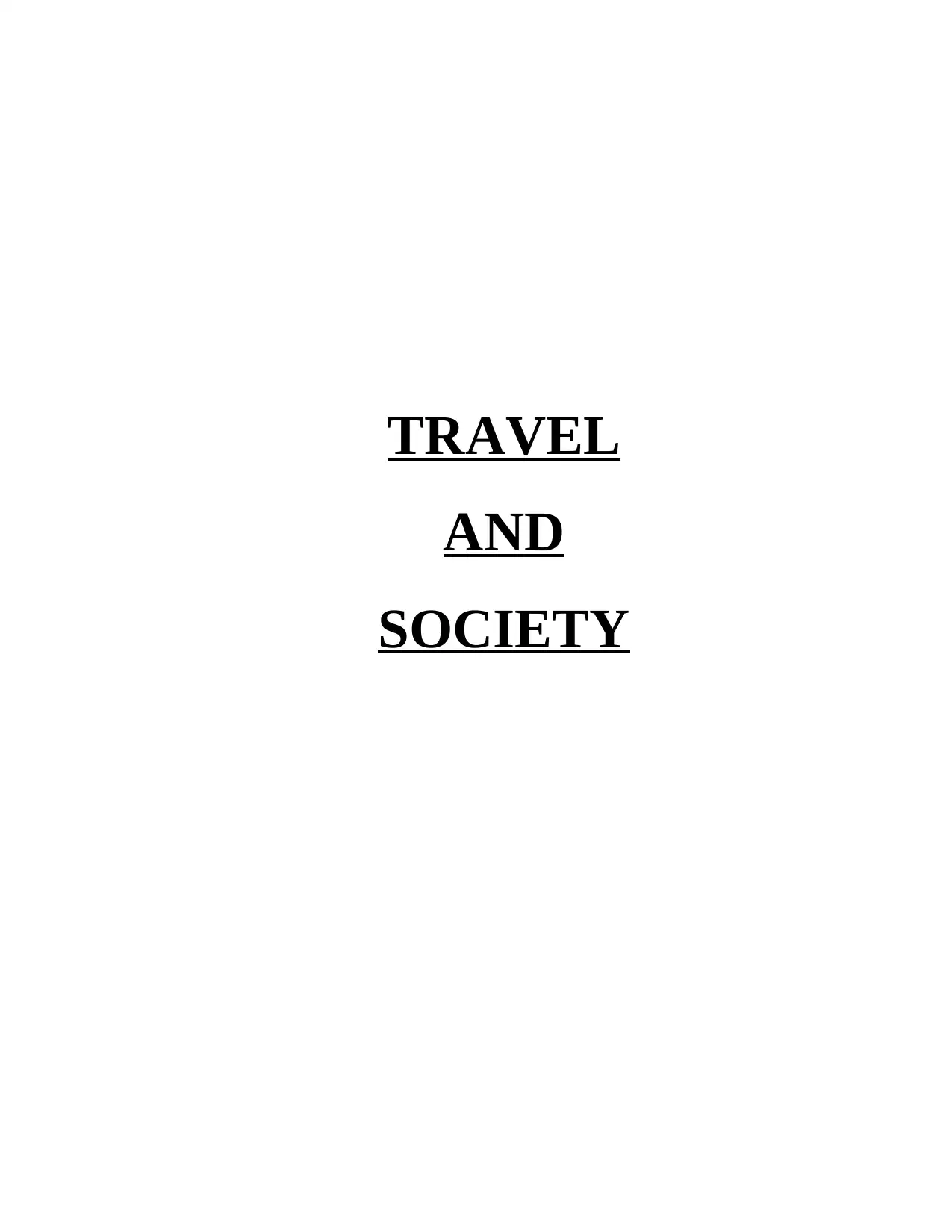
TRAVEL
AND
SOCIETY
AND
SOCIETY
Secure Best Marks with AI Grader
Need help grading? Try our AI Grader for instant feedback on your assignments.

Table of Contents
ESSAY: TOURISM AND SOCIETY.............................................................................................1
REFERENCES................................................................................................................................8
ESSAY: TOURISM AND SOCIETY.............................................................................................1
REFERENCES................................................................................................................................8
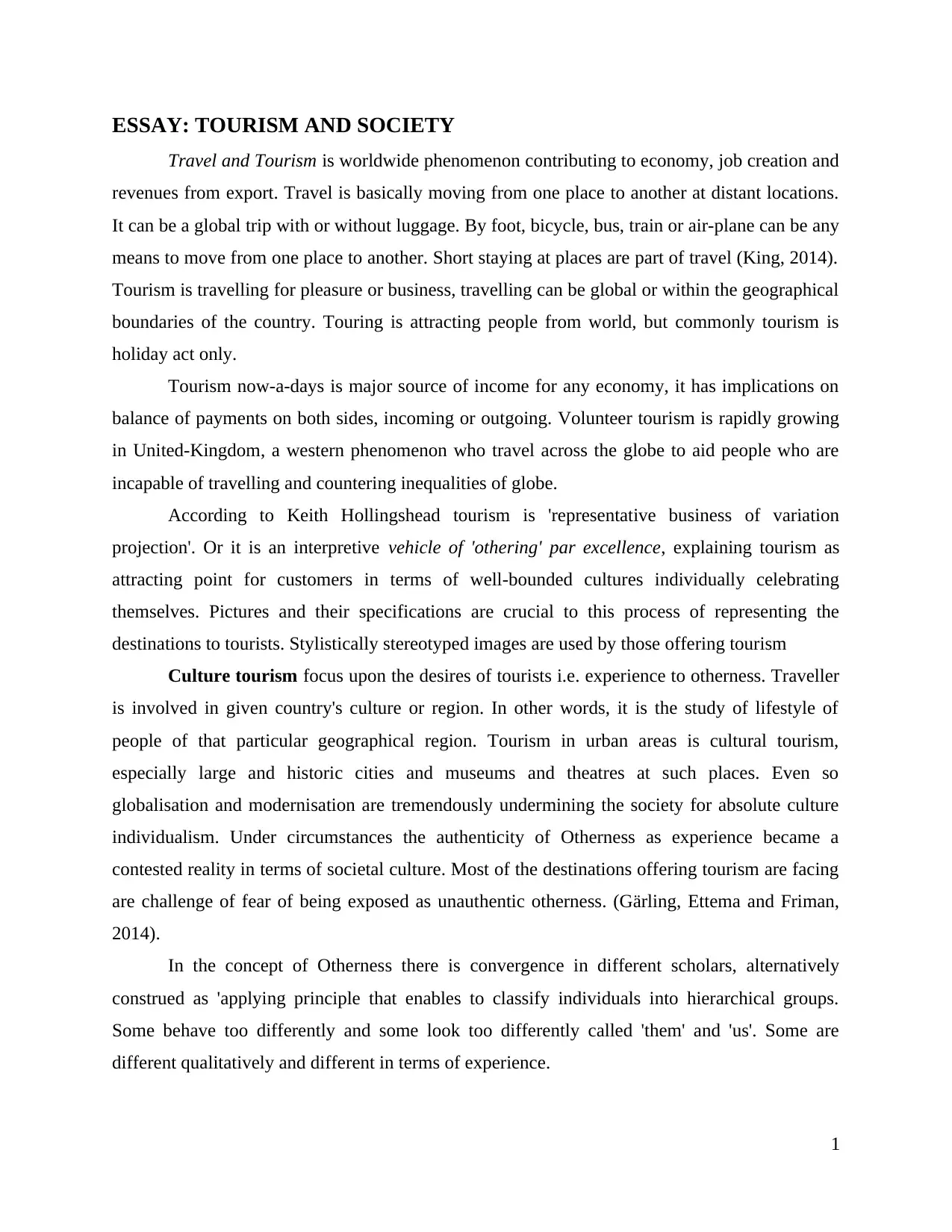
ESSAY: TOURISM AND SOCIETY
Travel and Tourism is worldwide phenomenon contributing to economy, job creation and
revenues from export. Travel is basically moving from one place to another at distant locations.
It can be a global trip with or without luggage. By foot, bicycle, bus, train or air-plane can be any
means to move from one place to another. Short staying at places are part of travel (King, 2014).
Tourism is travelling for pleasure or business, travelling can be global or within the geographical
boundaries of the country. Touring is attracting people from world, but commonly tourism is
holiday act only.
Tourism now-a-days is major source of income for any economy, it has implications on
balance of payments on both sides, incoming or outgoing. Volunteer tourism is rapidly growing
in United-Kingdom, a western phenomenon who travel across the globe to aid people who are
incapable of travelling and countering inequalities of globe.
According to Keith Hollingshead tourism is 'representative business of variation
projection'. Or it is an interpretive vehicle of 'othering' par excellence, explaining tourism as
attracting point for customers in terms of well-bounded cultures individually celebrating
themselves. Pictures and their specifications are crucial to this process of representing the
destinations to tourists. Stylistically stereotyped images are used by those offering tourism
Culture tourism focus upon the desires of tourists i.e. experience to otherness. Traveller
is involved in given country's culture or region. In other words, it is the study of lifestyle of
people of that particular geographical region. Tourism in urban areas is cultural tourism,
especially large and historic cities and museums and theatres at such places. Even so
globalisation and modernisation are tremendously undermining the society for absolute culture
individualism. Under circumstances the authenticity of Otherness as experience became a
contested reality in terms of societal culture. Most of the destinations offering tourism are facing
are challenge of fear of being exposed as unauthentic otherness. (Gärling, Ettema and Friman,
2014).
In the concept of Otherness there is convergence in different scholars, alternatively
construed as 'applying principle that enables to classify individuals into hierarchical groups.
Some behave too differently and some look too differently called 'them' and 'us'. Some are
different qualitatively and different in terms of experience.
1
Travel and Tourism is worldwide phenomenon contributing to economy, job creation and
revenues from export. Travel is basically moving from one place to another at distant locations.
It can be a global trip with or without luggage. By foot, bicycle, bus, train or air-plane can be any
means to move from one place to another. Short staying at places are part of travel (King, 2014).
Tourism is travelling for pleasure or business, travelling can be global or within the geographical
boundaries of the country. Touring is attracting people from world, but commonly tourism is
holiday act only.
Tourism now-a-days is major source of income for any economy, it has implications on
balance of payments on both sides, incoming or outgoing. Volunteer tourism is rapidly growing
in United-Kingdom, a western phenomenon who travel across the globe to aid people who are
incapable of travelling and countering inequalities of globe.
According to Keith Hollingshead tourism is 'representative business of variation
projection'. Or it is an interpretive vehicle of 'othering' par excellence, explaining tourism as
attracting point for customers in terms of well-bounded cultures individually celebrating
themselves. Pictures and their specifications are crucial to this process of representing the
destinations to tourists. Stylistically stereotyped images are used by those offering tourism
Culture tourism focus upon the desires of tourists i.e. experience to otherness. Traveller
is involved in given country's culture or region. In other words, it is the study of lifestyle of
people of that particular geographical region. Tourism in urban areas is cultural tourism,
especially large and historic cities and museums and theatres at such places. Even so
globalisation and modernisation are tremendously undermining the society for absolute culture
individualism. Under circumstances the authenticity of Otherness as experience became a
contested reality in terms of societal culture. Most of the destinations offering tourism are facing
are challenge of fear of being exposed as unauthentic otherness. (Gärling, Ettema and Friman,
2014).
In the concept of Otherness there is convergence in different scholars, alternatively
construed as 'applying principle that enables to classify individuals into hierarchical groups.
Some behave too differently and some look too differently called 'them' and 'us'. Some are
different qualitatively and different in terms of experience.
1
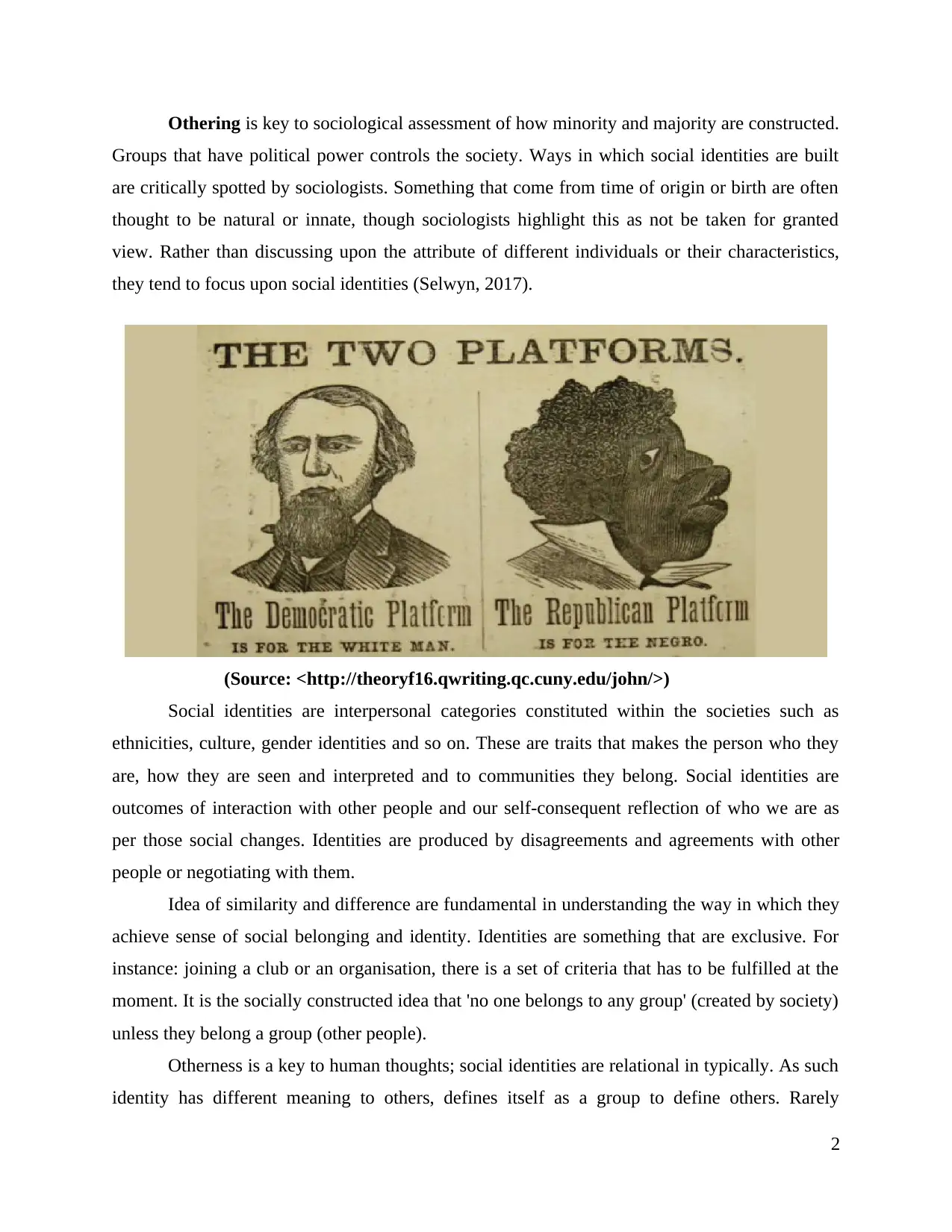
Othering is key to sociological assessment of how minority and majority are constructed.
Groups that have political power controls the society. Ways in which social identities are built
are critically spotted by sociologists. Something that come from time of origin or birth are often
thought to be natural or innate, though sociologists highlight this as not be taken for granted
view. Rather than discussing upon the attribute of different individuals or their characteristics,
they tend to focus upon social identities (Selwyn, 2017).
(Source: <http://theoryf16.qwriting.qc.cuny.edu/john/>)
Social identities are interpersonal categories constituted within the societies such as
ethnicities, culture, gender identities and so on. These are traits that makes the person who they
are, how they are seen and interpreted and to communities they belong. Social identities are
outcomes of interaction with other people and our self-consequent reflection of who we are as
per those social changes. Identities are produced by disagreements and agreements with other
people or negotiating with them.
Idea of similarity and difference are fundamental in understanding the way in which they
achieve sense of social belonging and identity. Identities are something that are exclusive. For
instance: joining a club or an organisation, there is a set of criteria that has to be fulfilled at the
moment. It is the socially constructed idea that 'no one belongs to any group' (created by society)
unless they belong a group (other people).
Otherness is a key to human thoughts; social identities are relational in typically. As such
identity has different meaning to others, defines itself as a group to define others. Rarely
2
Groups that have political power controls the society. Ways in which social identities are built
are critically spotted by sociologists. Something that come from time of origin or birth are often
thought to be natural or innate, though sociologists highlight this as not be taken for granted
view. Rather than discussing upon the attribute of different individuals or their characteristics,
they tend to focus upon social identities (Selwyn, 2017).
(Source: <http://theoryf16.qwriting.qc.cuny.edu/john/>)
Social identities are interpersonal categories constituted within the societies such as
ethnicities, culture, gender identities and so on. These are traits that makes the person who they
are, how they are seen and interpreted and to communities they belong. Social identities are
outcomes of interaction with other people and our self-consequent reflection of who we are as
per those social changes. Identities are produced by disagreements and agreements with other
people or negotiating with them.
Idea of similarity and difference are fundamental in understanding the way in which they
achieve sense of social belonging and identity. Identities are something that are exclusive. For
instance: joining a club or an organisation, there is a set of criteria that has to be fulfilled at the
moment. It is the socially constructed idea that 'no one belongs to any group' (created by society)
unless they belong a group (other people).
Otherness is a key to human thoughts; social identities are relational in typically. As such
identity has different meaning to others, defines itself as a group to define others. Rarely
2
Secure Best Marks with AI Grader
Need help grading? Try our AI Grader for instant feedback on your assignments.
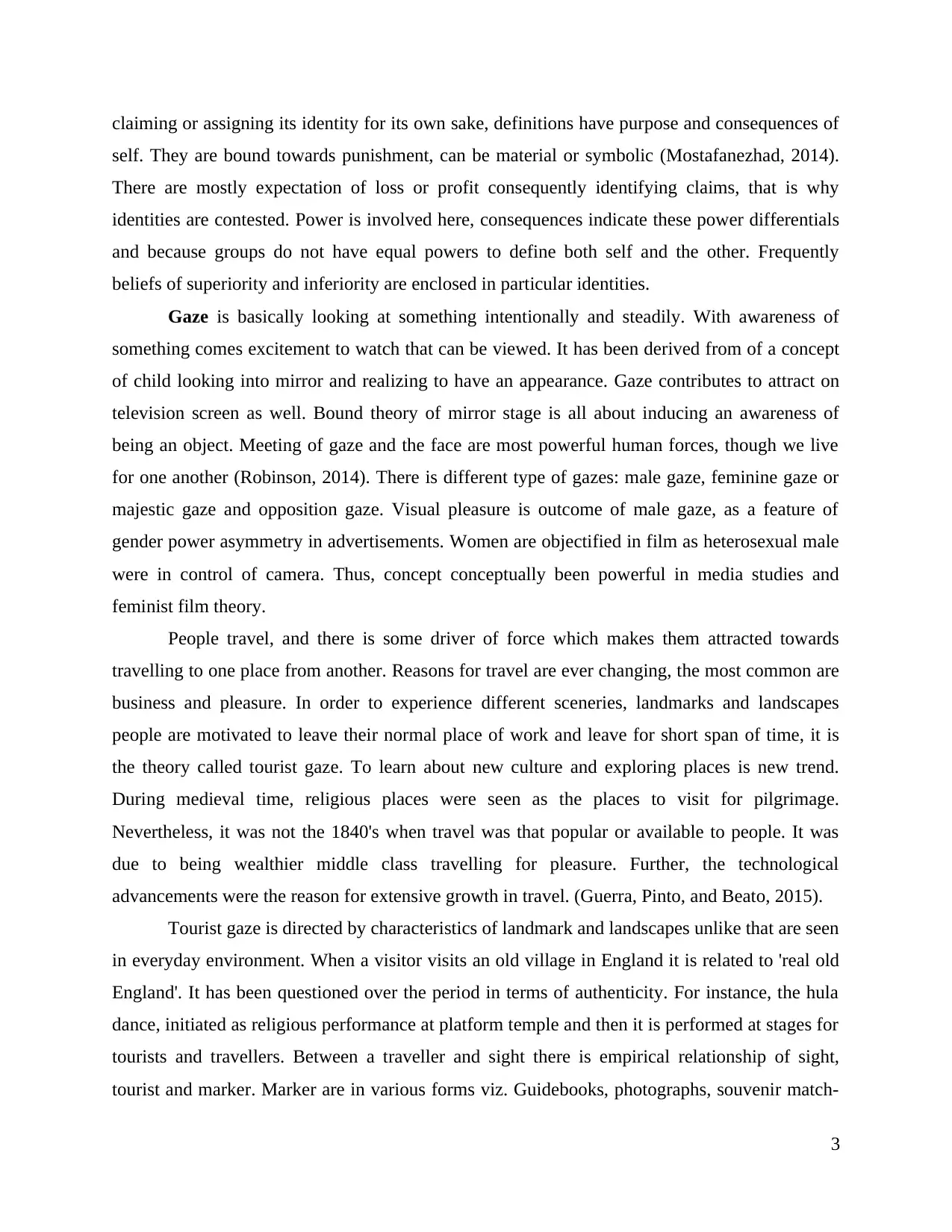
claiming or assigning its identity for its own sake, definitions have purpose and consequences of
self. They are bound towards punishment, can be material or symbolic (Mostafanezhad, 2014).
There are mostly expectation of loss or profit consequently identifying claims, that is why
identities are contested. Power is involved here, consequences indicate these power differentials
and because groups do not have equal powers to define both self and the other. Frequently
beliefs of superiority and inferiority are enclosed in particular identities.
Gaze is basically looking at something intentionally and steadily. With awareness of
something comes excitement to watch that can be viewed. It has been derived from of a concept
of child looking into mirror and realizing to have an appearance. Gaze contributes to attract on
television screen as well. Bound theory of mirror stage is all about inducing an awareness of
being an object. Meeting of gaze and the face are most powerful human forces, though we live
for one another (Robinson, 2014). There is different type of gazes: male gaze, feminine gaze or
majestic gaze and opposition gaze. Visual pleasure is outcome of male gaze, as a feature of
gender power asymmetry in advertisements. Women are objectified in film as heterosexual male
were in control of camera. Thus, concept conceptually been powerful in media studies and
feminist film theory.
People travel, and there is some driver of force which makes them attracted towards
travelling to one place from another. Reasons for travel are ever changing, the most common are
business and pleasure. In order to experience different sceneries, landmarks and landscapes
people are motivated to leave their normal place of work and leave for short span of time, it is
the theory called tourist gaze. To learn about new culture and exploring places is new trend.
During medieval time, religious places were seen as the places to visit for pilgrimage.
Nevertheless, it was not the 1840's when travel was that popular or available to people. It was
due to being wealthier middle class travelling for pleasure. Further, the technological
advancements were the reason for extensive growth in travel. (Guerra, Pinto, and Beato, 2015).
Tourist gaze is directed by characteristics of landmark and landscapes unlike that are seen
in everyday environment. When a visitor visits an old village in England it is related to 'real old
England'. It has been questioned over the period in terms of authenticity. For instance, the hula
dance, initiated as religious performance at platform temple and then it is performed at stages for
tourists and travellers. Between a traveller and sight there is empirical relationship of sight,
tourist and marker. Marker are in various forms viz. Guidebooks, photographs, souvenir match-
3
self. They are bound towards punishment, can be material or symbolic (Mostafanezhad, 2014).
There are mostly expectation of loss or profit consequently identifying claims, that is why
identities are contested. Power is involved here, consequences indicate these power differentials
and because groups do not have equal powers to define both self and the other. Frequently
beliefs of superiority and inferiority are enclosed in particular identities.
Gaze is basically looking at something intentionally and steadily. With awareness of
something comes excitement to watch that can be viewed. It has been derived from of a concept
of child looking into mirror and realizing to have an appearance. Gaze contributes to attract on
television screen as well. Bound theory of mirror stage is all about inducing an awareness of
being an object. Meeting of gaze and the face are most powerful human forces, though we live
for one another (Robinson, 2014). There is different type of gazes: male gaze, feminine gaze or
majestic gaze and opposition gaze. Visual pleasure is outcome of male gaze, as a feature of
gender power asymmetry in advertisements. Women are objectified in film as heterosexual male
were in control of camera. Thus, concept conceptually been powerful in media studies and
feminist film theory.
People travel, and there is some driver of force which makes them attracted towards
travelling to one place from another. Reasons for travel are ever changing, the most common are
business and pleasure. In order to experience different sceneries, landmarks and landscapes
people are motivated to leave their normal place of work and leave for short span of time, it is
the theory called tourist gaze. To learn about new culture and exploring places is new trend.
During medieval time, religious places were seen as the places to visit for pilgrimage.
Nevertheless, it was not the 1840's when travel was that popular or available to people. It was
due to being wealthier middle class travelling for pleasure. Further, the technological
advancements were the reason for extensive growth in travel. (Guerra, Pinto, and Beato, 2015).
Tourist gaze is directed by characteristics of landmark and landscapes unlike that are seen
in everyday environment. When a visitor visits an old village in England it is related to 'real old
England'. It has been questioned over the period in terms of authenticity. For instance, the hula
dance, initiated as religious performance at platform temple and then it is performed at stages for
tourists and travellers. Between a traveller and sight there is empirical relationship of sight,
tourist and marker. Marker are in various forms viz. Guidebooks, photographs, souvenir match-
3
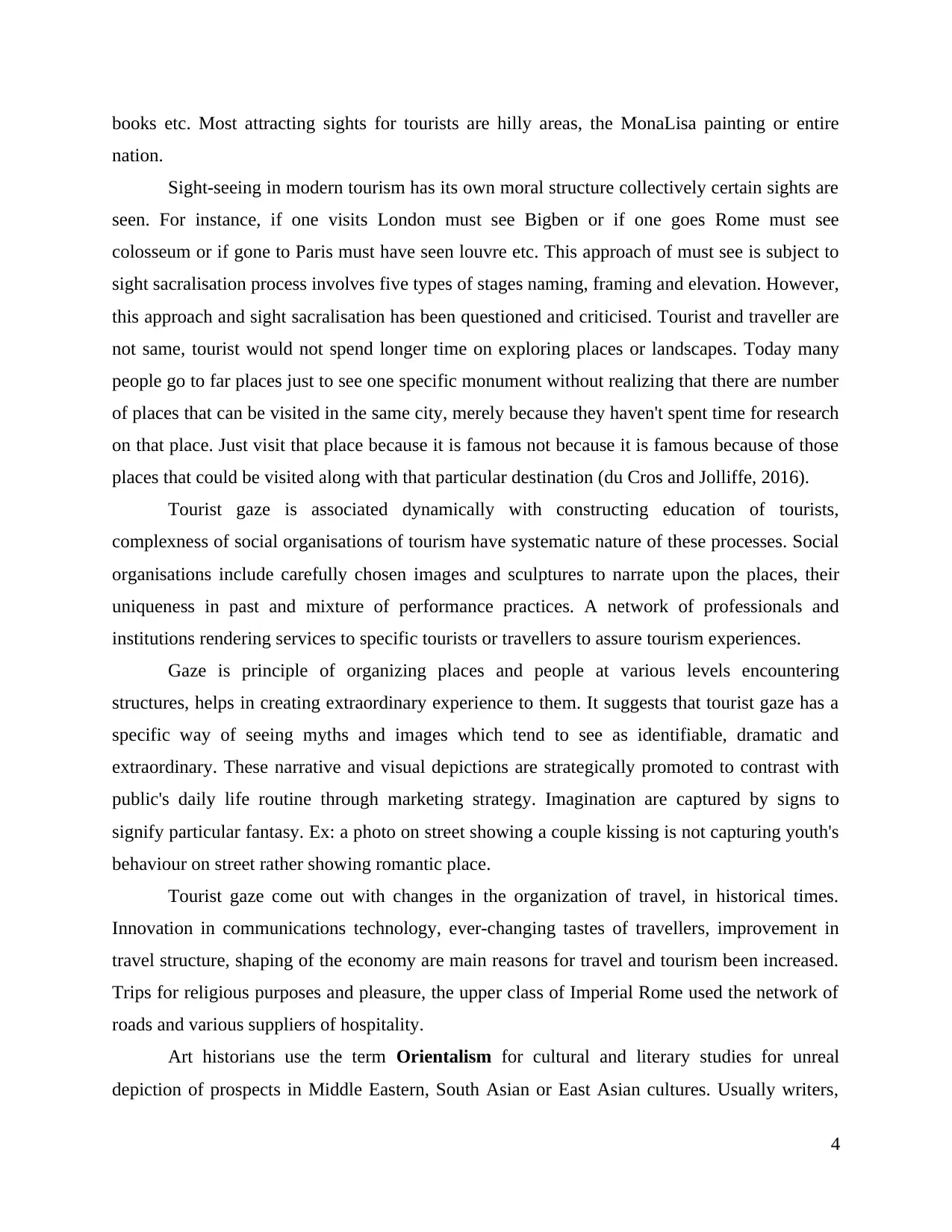
books etc. Most attracting sights for tourists are hilly areas, the MonaLisa painting or entire
nation.
Sight-seeing in modern tourism has its own moral structure collectively certain sights are
seen. For instance, if one visits London must see Bigben or if one goes Rome must see
colosseum or if gone to Paris must have seen louvre etc. This approach of must see is subject to
sight sacralisation process involves five types of stages naming, framing and elevation. However,
this approach and sight sacralisation has been questioned and criticised. Tourist and traveller are
not same, tourist would not spend longer time on exploring places or landscapes. Today many
people go to far places just to see one specific monument without realizing that there are number
of places that can be visited in the same city, merely because they haven't spent time for research
on that place. Just visit that place because it is famous not because it is famous because of those
places that could be visited along with that particular destination (du Cros and Jolliffe, 2016).
Tourist gaze is associated dynamically with constructing education of tourists,
complexness of social organisations of tourism have systematic nature of these processes. Social
organisations include carefully chosen images and sculptures to narrate upon the places, their
uniqueness in past and mixture of performance practices. A network of professionals and
institutions rendering services to specific tourists or travellers to assure tourism experiences.
Gaze is principle of organizing places and people at various levels encountering
structures, helps in creating extraordinary experience to them. It suggests that tourist gaze has a
specific way of seeing myths and images which tend to see as identifiable, dramatic and
extraordinary. These narrative and visual depictions are strategically promoted to contrast with
public's daily life routine through marketing strategy. Imagination are captured by signs to
signify particular fantasy. Ex: a photo on street showing a couple kissing is not capturing youth's
behaviour on street rather showing romantic place.
Tourist gaze come out with changes in the organization of travel, in historical times.
Innovation in communications technology, ever-changing tastes of travellers, improvement in
travel structure, shaping of the economy are main reasons for travel and tourism been increased.
Trips for religious purposes and pleasure, the upper class of Imperial Rome used the network of
roads and various suppliers of hospitality.
Art historians use the term Orientalism for cultural and literary studies for unreal
depiction of prospects in Middle Eastern, South Asian or East Asian cultures. Usually writers,
4
nation.
Sight-seeing in modern tourism has its own moral structure collectively certain sights are
seen. For instance, if one visits London must see Bigben or if one goes Rome must see
colosseum or if gone to Paris must have seen louvre etc. This approach of must see is subject to
sight sacralisation process involves five types of stages naming, framing and elevation. However,
this approach and sight sacralisation has been questioned and criticised. Tourist and traveller are
not same, tourist would not spend longer time on exploring places or landscapes. Today many
people go to far places just to see one specific monument without realizing that there are number
of places that can be visited in the same city, merely because they haven't spent time for research
on that place. Just visit that place because it is famous not because it is famous because of those
places that could be visited along with that particular destination (du Cros and Jolliffe, 2016).
Tourist gaze is associated dynamically with constructing education of tourists,
complexness of social organisations of tourism have systematic nature of these processes. Social
organisations include carefully chosen images and sculptures to narrate upon the places, their
uniqueness in past and mixture of performance practices. A network of professionals and
institutions rendering services to specific tourists or travellers to assure tourism experiences.
Gaze is principle of organizing places and people at various levels encountering
structures, helps in creating extraordinary experience to them. It suggests that tourist gaze has a
specific way of seeing myths and images which tend to see as identifiable, dramatic and
extraordinary. These narrative and visual depictions are strategically promoted to contrast with
public's daily life routine through marketing strategy. Imagination are captured by signs to
signify particular fantasy. Ex: a photo on street showing a couple kissing is not capturing youth's
behaviour on street rather showing romantic place.
Tourist gaze come out with changes in the organization of travel, in historical times.
Innovation in communications technology, ever-changing tastes of travellers, improvement in
travel structure, shaping of the economy are main reasons for travel and tourism been increased.
Trips for religious purposes and pleasure, the upper class of Imperial Rome used the network of
roads and various suppliers of hospitality.
Art historians use the term Orientalism for cultural and literary studies for unreal
depiction of prospects in Middle Eastern, South Asian or East Asian cultures. Usually writers,
4
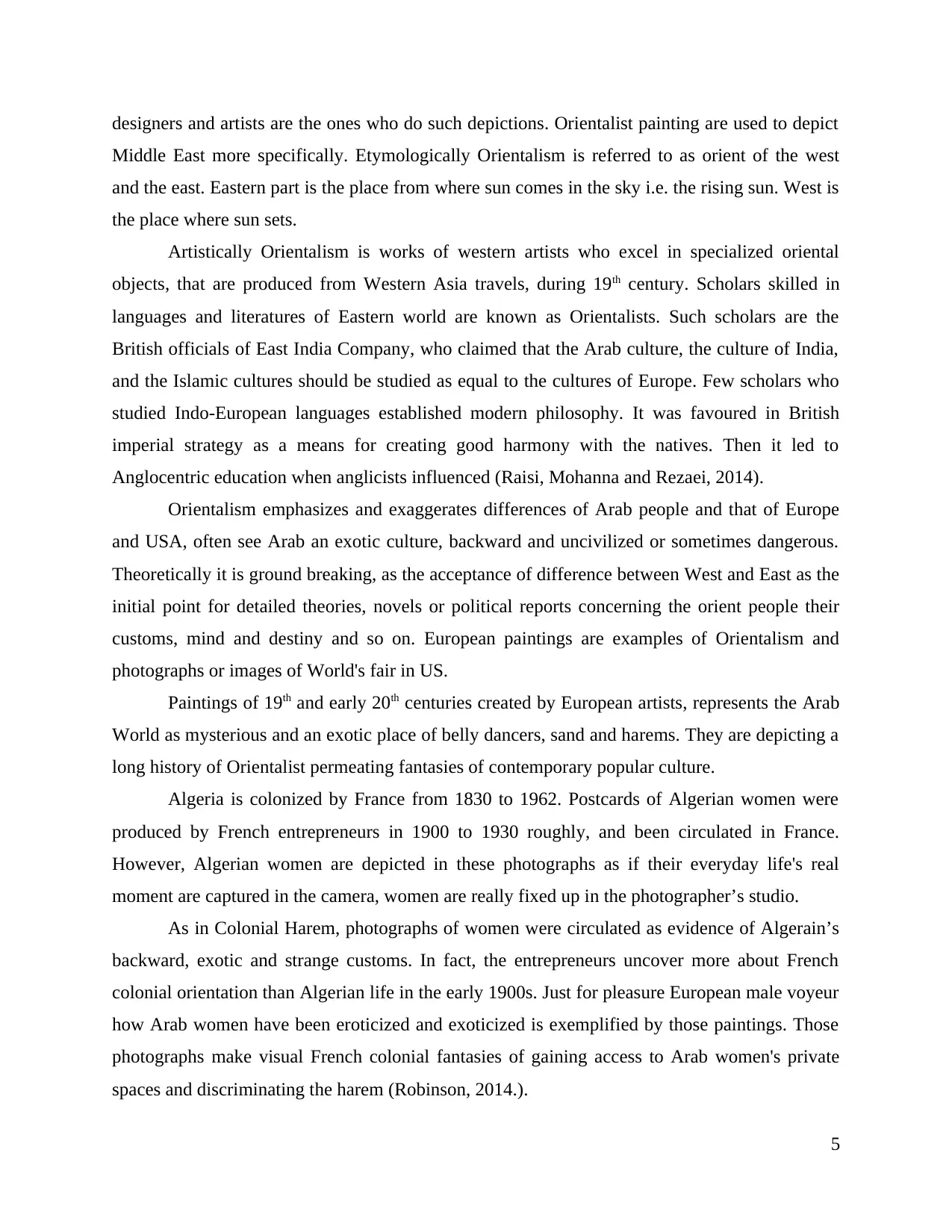
designers and artists are the ones who do such depictions. Orientalist painting are used to depict
Middle East more specifically. Etymologically Orientalism is referred to as orient of the west
and the east. Eastern part is the place from where sun comes in the sky i.e. the rising sun. West is
the place where sun sets.
Artistically Orientalism is works of western artists who excel in specialized oriental
objects, that are produced from Western Asia travels, during 19th century. Scholars skilled in
languages and literatures of Eastern world are known as Orientalists. Such scholars are the
British officials of East India Company, who claimed that the Arab culture, the culture of India,
and the Islamic cultures should be studied as equal to the cultures of Europe. Few scholars who
studied Indo-European languages established modern philosophy. It was favoured in British
imperial strategy as a means for creating good harmony with the natives. Then it led to
Anglocentric education when anglicists influenced (Raisi, Mohanna and Rezaei, 2014).
Orientalism emphasizes and exaggerates differences of Arab people and that of Europe
and USA, often see Arab an exotic culture, backward and uncivilized or sometimes dangerous.
Theoretically it is ground breaking, as the acceptance of difference between West and East as the
initial point for detailed theories, novels or political reports concerning the orient people their
customs, mind and destiny and so on. European paintings are examples of Orientalism and
photographs or images of World's fair in US.
Paintings of 19th and early 20th centuries created by European artists, represents the Arab
World as mysterious and an exotic place of belly dancers, sand and harems. They are depicting a
long history of Orientalist permeating fantasies of contemporary popular culture.
Algeria is colonized by France from 1830 to 1962. Postcards of Algerian women were
produced by French entrepreneurs in 1900 to 1930 roughly, and been circulated in France.
However, Algerian women are depicted in these photographs as if their everyday life's real
moment are captured in the camera, women are really fixed up in the photographer’s studio.
As in Colonial Harem, photographs of women were circulated as evidence of Algerain’s
backward, exotic and strange customs. In fact, the entrepreneurs uncover more about French
colonial orientation than Algerian life in the early 1900s. Just for pleasure European male voyeur
how Arab women have been eroticized and exoticized is exemplified by those paintings. Those
photographs make visual French colonial fantasies of gaining access to Arab women's private
spaces and discriminating the harem (Robinson, 2014.).
5
Middle East more specifically. Etymologically Orientalism is referred to as orient of the west
and the east. Eastern part is the place from where sun comes in the sky i.e. the rising sun. West is
the place where sun sets.
Artistically Orientalism is works of western artists who excel in specialized oriental
objects, that are produced from Western Asia travels, during 19th century. Scholars skilled in
languages and literatures of Eastern world are known as Orientalists. Such scholars are the
British officials of East India Company, who claimed that the Arab culture, the culture of India,
and the Islamic cultures should be studied as equal to the cultures of Europe. Few scholars who
studied Indo-European languages established modern philosophy. It was favoured in British
imperial strategy as a means for creating good harmony with the natives. Then it led to
Anglocentric education when anglicists influenced (Raisi, Mohanna and Rezaei, 2014).
Orientalism emphasizes and exaggerates differences of Arab people and that of Europe
and USA, often see Arab an exotic culture, backward and uncivilized or sometimes dangerous.
Theoretically it is ground breaking, as the acceptance of difference between West and East as the
initial point for detailed theories, novels or political reports concerning the orient people their
customs, mind and destiny and so on. European paintings are examples of Orientalism and
photographs or images of World's fair in US.
Paintings of 19th and early 20th centuries created by European artists, represents the Arab
World as mysterious and an exotic place of belly dancers, sand and harems. They are depicting a
long history of Orientalist permeating fantasies of contemporary popular culture.
Algeria is colonized by France from 1830 to 1962. Postcards of Algerian women were
produced by French entrepreneurs in 1900 to 1930 roughly, and been circulated in France.
However, Algerian women are depicted in these photographs as if their everyday life's real
moment are captured in the camera, women are really fixed up in the photographer’s studio.
As in Colonial Harem, photographs of women were circulated as evidence of Algerain’s
backward, exotic and strange customs. In fact, the entrepreneurs uncover more about French
colonial orientation than Algerian life in the early 1900s. Just for pleasure European male voyeur
how Arab women have been eroticized and exoticized is exemplified by those paintings. Those
photographs make visual French colonial fantasies of gaining access to Arab women's private
spaces and discriminating the harem (Robinson, 2014.).
5
Paraphrase This Document
Need a fresh take? Get an instant paraphrase of this document with our AI Paraphraser
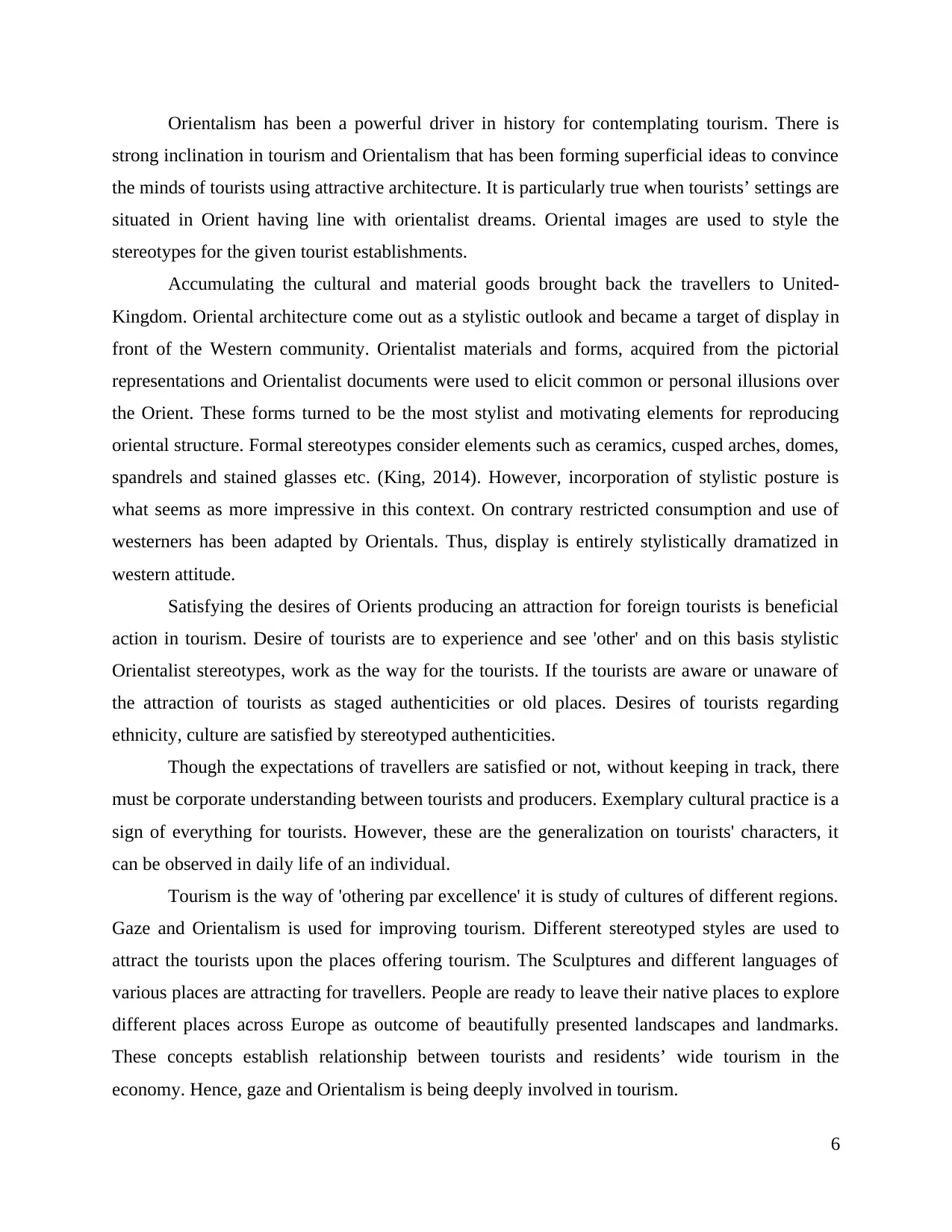
Orientalism has been a powerful driver in history for contemplating tourism. There is
strong inclination in tourism and Orientalism that has been forming superficial ideas to convince
the minds of tourists using attractive architecture. It is particularly true when tourists’ settings are
situated in Orient having line with orientalist dreams. Oriental images are used to style the
stereotypes for the given tourist establishments.
Accumulating the cultural and material goods brought back the travellers to United-
Kingdom. Oriental architecture come out as a stylistic outlook and became a target of display in
front of the Western community. Orientalist materials and forms, acquired from the pictorial
representations and Orientalist documents were used to elicit common or personal illusions over
the Orient. These forms turned to be the most stylist and motivating elements for reproducing
oriental structure. Formal stereotypes consider elements such as ceramics, cusped arches, domes,
spandrels and stained glasses etc. (King, 2014). However, incorporation of stylistic posture is
what seems as more impressive in this context. On contrary restricted consumption and use of
westerners has been adapted by Orientals. Thus, display is entirely stylistically dramatized in
western attitude.
Satisfying the desires of Orients producing an attraction for foreign tourists is beneficial
action in tourism. Desire of tourists are to experience and see 'other' and on this basis stylistic
Orientalist stereotypes, work as the way for the tourists. If the tourists are aware or unaware of
the attraction of tourists as staged authenticities or old places. Desires of tourists regarding
ethnicity, culture are satisfied by stereotyped authenticities.
Though the expectations of travellers are satisfied or not, without keeping in track, there
must be corporate understanding between tourists and producers. Exemplary cultural practice is a
sign of everything for tourists. However, these are the generalization on tourists' characters, it
can be observed in daily life of an individual.
Tourism is the way of 'othering par excellence' it is study of cultures of different regions.
Gaze and Orientalism is used for improving tourism. Different stereotyped styles are used to
attract the tourists upon the places offering tourism. The Sculptures and different languages of
various places are attracting for travellers. People are ready to leave their native places to explore
different places across Europe as outcome of beautifully presented landscapes and landmarks.
These concepts establish relationship between tourists and residents’ wide tourism in the
economy. Hence, gaze and Orientalism is being deeply involved in tourism.
6
strong inclination in tourism and Orientalism that has been forming superficial ideas to convince
the minds of tourists using attractive architecture. It is particularly true when tourists’ settings are
situated in Orient having line with orientalist dreams. Oriental images are used to style the
stereotypes for the given tourist establishments.
Accumulating the cultural and material goods brought back the travellers to United-
Kingdom. Oriental architecture come out as a stylistic outlook and became a target of display in
front of the Western community. Orientalist materials and forms, acquired from the pictorial
representations and Orientalist documents were used to elicit common or personal illusions over
the Orient. These forms turned to be the most stylist and motivating elements for reproducing
oriental structure. Formal stereotypes consider elements such as ceramics, cusped arches, domes,
spandrels and stained glasses etc. (King, 2014). However, incorporation of stylistic posture is
what seems as more impressive in this context. On contrary restricted consumption and use of
westerners has been adapted by Orientals. Thus, display is entirely stylistically dramatized in
western attitude.
Satisfying the desires of Orients producing an attraction for foreign tourists is beneficial
action in tourism. Desire of tourists are to experience and see 'other' and on this basis stylistic
Orientalist stereotypes, work as the way for the tourists. If the tourists are aware or unaware of
the attraction of tourists as staged authenticities or old places. Desires of tourists regarding
ethnicity, culture are satisfied by stereotyped authenticities.
Though the expectations of travellers are satisfied or not, without keeping in track, there
must be corporate understanding between tourists and producers. Exemplary cultural practice is a
sign of everything for tourists. However, these are the generalization on tourists' characters, it
can be observed in daily life of an individual.
Tourism is the way of 'othering par excellence' it is study of cultures of different regions.
Gaze and Orientalism is used for improving tourism. Different stereotyped styles are used to
attract the tourists upon the places offering tourism. The Sculptures and different languages of
various places are attracting for travellers. People are ready to leave their native places to explore
different places across Europe as outcome of beautifully presented landscapes and landmarks.
These concepts establish relationship between tourists and residents’ wide tourism in the
economy. Hence, gaze and Orientalism is being deeply involved in tourism.
6
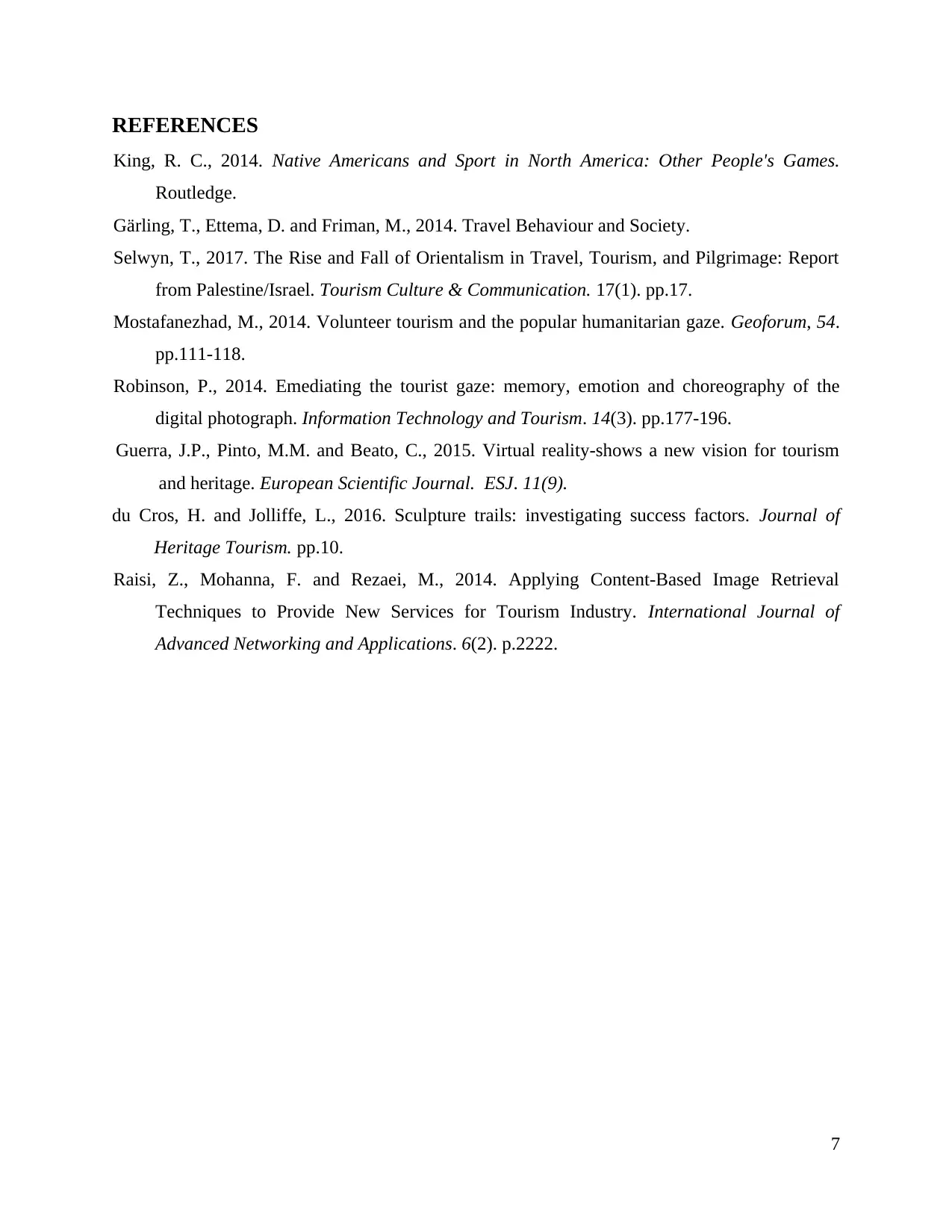
REFERENCES
King, R. C., 2014. Native Americans and Sport in North America: Other People's Games.
Routledge.
Gärling, T., Ettema, D. and Friman, M., 2014. Travel Behaviour and Society.
Selwyn, T., 2017. The Rise and Fall of Orientalism in Travel, Tourism, and Pilgrimage: Report
from Palestine/Israel. Tourism Culture & Communication. 17(1). pp.17.
Mostafanezhad, M., 2014. Volunteer tourism and the popular humanitarian gaze. Geoforum, 54.
pp.111-118.
Robinson, P., 2014. Emediating the tourist gaze: memory, emotion and choreography of the
digital photograph. Information Technology and Tourism. 14(3). pp.177-196.
Guerra, J.P., Pinto, M.M. and Beato, C., 2015. Virtual reality-shows a new vision for tourism
and heritage. European Scientific Journal. ESJ. 11(9).
du Cros, H. and Jolliffe, L., 2016. Sculpture trails: investigating success factors. Journal of
Heritage Tourism. pp.10.
Raisi, Z., Mohanna, F. and Rezaei, M., 2014. Applying Content-Based Image Retrieval
Techniques to Provide New Services for Tourism Industry. International Journal of
Advanced Networking and Applications. 6(2). p.2222.
7
King, R. C., 2014. Native Americans and Sport in North America: Other People's Games.
Routledge.
Gärling, T., Ettema, D. and Friman, M., 2014. Travel Behaviour and Society.
Selwyn, T., 2017. The Rise and Fall of Orientalism in Travel, Tourism, and Pilgrimage: Report
from Palestine/Israel. Tourism Culture & Communication. 17(1). pp.17.
Mostafanezhad, M., 2014. Volunteer tourism and the popular humanitarian gaze. Geoforum, 54.
pp.111-118.
Robinson, P., 2014. Emediating the tourist gaze: memory, emotion and choreography of the
digital photograph. Information Technology and Tourism. 14(3). pp.177-196.
Guerra, J.P., Pinto, M.M. and Beato, C., 2015. Virtual reality-shows a new vision for tourism
and heritage. European Scientific Journal. ESJ. 11(9).
du Cros, H. and Jolliffe, L., 2016. Sculpture trails: investigating success factors. Journal of
Heritage Tourism. pp.10.
Raisi, Z., Mohanna, F. and Rezaei, M., 2014. Applying Content-Based Image Retrieval
Techniques to Provide New Services for Tourism Industry. International Journal of
Advanced Networking and Applications. 6(2). p.2222.
7
1 out of 9
Related Documents
Your All-in-One AI-Powered Toolkit for Academic Success.
+13062052269
info@desklib.com
Available 24*7 on WhatsApp / Email
![[object Object]](/_next/static/media/star-bottom.7253800d.svg)
Unlock your academic potential
© 2024 | Zucol Services PVT LTD | All rights reserved.



